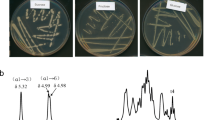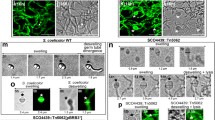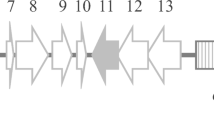Abstract
The objective of this study was to purify, characterize, and phylogenetically and structurally analyze the dextranase produced by the fungus Pochonia chlamydosporia. Dextranase produced by the fungus P. chlamydosporia was purified to homogeneity in two steps, with a yield of 152%, purification factor of 6.84 and specific activity of 358.63 U/mg. Its molecular weight was estimated by SDS-PAGE at 64 kDa. The enzyme presented higher activity at 50 °C and pH 5.0, using 100 mM citrate–phosphate buffer, was inhibited by Ag1+, Hg2+, Cu2+, Mg2+, and presented KM of 23.60 µM. Mature dextranase is composed of 585 amino acids residues, with a predicted molecular weight of 64.38 kDa and pI 5.96. This dextranase showed a strong phylogenetic similarity when compared to Trichoderma harzianum dextranase. Its structure consists of two domains: the first composed by 15 β strands, and the second composed by a right-handed parallel β-helix.






Similar content being viewed by others
References
Abdel-Aziz MS, Fatma Talkhan N, Janson J (2007) Purification and characterization of dextranase from a new strain of Penicillium funiculosum. J Appl Sci Res 3:1509–1516
Abdel-Naby MA, Ismail A-MS, Abdel-Fattah AM, Abdel-Fattah AF (1999) Preparation and some properties of immobilized Penicillium funiculosum 258 dextranase. Process Biochem 34:391–398
Batista MCT (2014) Produção de dextranases a partir de bagaço de malte: caracterização e avaliação do potencial de aplicaçao em indústria sucroalcooleira. Thesis, Universidade Federal do Paraná
Bhatia S, Bhakri G, Arora M, Uppal SK, Batta SK (2010) Dextranase production from Paecilomyces lilacinus and its application for dextran removal from sugarcane juice. Sugar Tech 12:133–138
Boil PGMD, Wienese S (2002) Enzymic reduction of dextran in process-laboratory evaluation of dextranases. In: Proceedings of South African Sugar Technologist Association 76:435–443
Bradford MM (1976) A rapid and sensitive method for the quantitation of microgram quantities of protein utilizing the principle of protein-dye binding. Anal Biochem 72:248–254
CAZy—Carbohydrate Active Enzymes (2017) http://www.cazy.org/Glycoside-Hydrolases.html. Acessed 16 March 2017
El-Shamy AR, Atalla SMM (2014) Immobilization of dextranase by Aspergillus penicillioides NRC 39 and its properties. Afr J Microbiol Res 8:3893–3900
Hattori A, Ishibashi K, Minato S (1981) The purification and characterization of the dextranase of Chaetomium gracile. Agric Biol Chem 45:2409–2416
Jaiswal P, Kumar S (2011) Impact of media on isolation of dextranase producing fungal strains. J Sci Res 55:71–76
Jiao Y, Wang S, Lv M, Jiao B, Li W, Fang Y, Liu S (2014) Characterization of a marine-derived dextranase and its application to the prevention of dental caries. J Ind Microbiol Biotechnol 41:17–26
Jiménez ER (2009) Dextranase in sugar industry: a review. Sugar Tech 11:124–134
Khalikova E, Susi P, Korpela T (2005) Microbial dextran-hydrolyzing enzymes: fundamentals and applications. Microbiol Mol Biol Rev 69:306–325
Laemmli UK (1970) Cleavage of structural proteins during the assembly of the head of bacteriophage T4. Nature 227:680–685
Larsson AM, Andersson R, Ståhlberg J, Kenne L, Jones TA (2003) Dextranase from Penicillium minioluteum: reaction course, crystal structure, and product complex. Structure 11:1111–1121
Machado FPP (2009) Produção, purificação e caracterização bioquímica da dextranase de Paecilomyces marquandii. Thesis, Universidade Federal de Viçosa
Mahmoud KF, Gibriel AY, Amin AA, Nessrien MN, Yassien NM, El Banna HA (2014) Microbial production and characterization of dextranase. Int J Curr Microbiol Appl Sci 3:1095–1113
Miller GL (1959) Use of dinitrosalicylic acid reagent for determination of reducing sugar. Anal Chem 31:426–428
Mizuno M, Koide A, Yamamura A, Akeboshi H, Yoshida H, Kamitori S, Sakano Y, Nishikawa A, Tonozuka T (2008) Crystal structure of Aspergillus niger isopullulanase, a member of glycoside hydrolase family 49. J Mol Biol 376:210–220
Morya VK, Yadav S, Kim EK, Yadav D (2012) In silico characterization of alkaline proteases from different species of Aspergillus. Appl Biochem Biotechnol 166:243–257
Picozzi C, Meissner D, Chierici M, Ehrmann MA, Vigentini I, Foschino R, Vogel RF (2015) Phage-mediated transfer of a dextranase gene in Lactobacillus sanfranciscensis and characterization of the enzyme. Int J Food Microbiol 202:48–53
Singleton V, Horn J, Bucke C, Adlard M (2002) A new polarimetric method for the analysis of dextran and sucrose. J Am Soc Sugarcane Technol 22:112–119
Sufiate BL, Soares FEF, Gouveia AS, Moreira SS, Cardoso EF, Tavares GP, Braga FR, Araujo JV, Queiroz JH (2018) Statistical tools application on dextranase production from Pochonia chlamydosporia (VC4) and its application on dextran removal from sugarcane juice. An Acad Bras Cienc (accepted)
Sugiura M, Ito A, Ogiso T, Kato K, Asano H (1973) Studies on dextranase: purification of dextranase from Penicillium funiculosum and its enzymatic properties. Biochim Biophys Acta 309:357–362
Virgen-Ortíz JJ, Ibarra-Junquera V, Escalante-Minakata P, Ornelas-Paz JJ, Osuna-Castro JA, González-Potes A (2015) Kinetics and thermodynamic of the purified dextranase from Chaetomium erraticum. J Mol Catal B Enzym 122:80–86
Wang X, Lu M, Wang S, Fang Y, Wang D, Ren W, Zhao G (2014) The atmospheric and room-temperature plasma (ARTP) method on the dextranase activity and structure. Int J Biol Macromol 70:284–291
Wynter CVA, Galeal CF, Cox LM, Dawsonl MW, Patel BK, Hamilton S, De Jersey J, Inkerman PA (1995) Thermostable dextranases: screening, detection and preliminary characterization. J Appl Bacteriol 79:203–212
Zhang Y, Li R, Zhang H, Wu M, Hu X (2016) Purification, characterization, and application of a thermostable dextranase from Talaromyces pinophilus. J Ind Microbiol Biotechnol 44:317–327
Acknowledgements
The authors would like to thank the Coordenação de Aperfeiçoamento de Pessoal de Nível Superior (CAPES), the Fundação de Amparo à Pesquisa de Minas Gerais (FAPEMIG), and the Conselho Nacional de Desenvolvimento Científico e Tecnológico (CNPq) for the financial support.
Author information
Authors and Affiliations
Corresponding author
Ethics declarations
Conflicts of interest
The authors declare that they have no conflict of interest.
Rights and permissions
About this article
Cite this article
Sufiate, B.L., Soares, F.E.d., Moreira, S.S. et al. In vitro and in silico characterization of a novel dextranase from Pochonia chlamydosporia. 3 Biotech 8, 167 (2018). https://doi.org/10.1007/s13205-018-1192-4
Received:
Accepted:
Published:
DOI: https://doi.org/10.1007/s13205-018-1192-4




